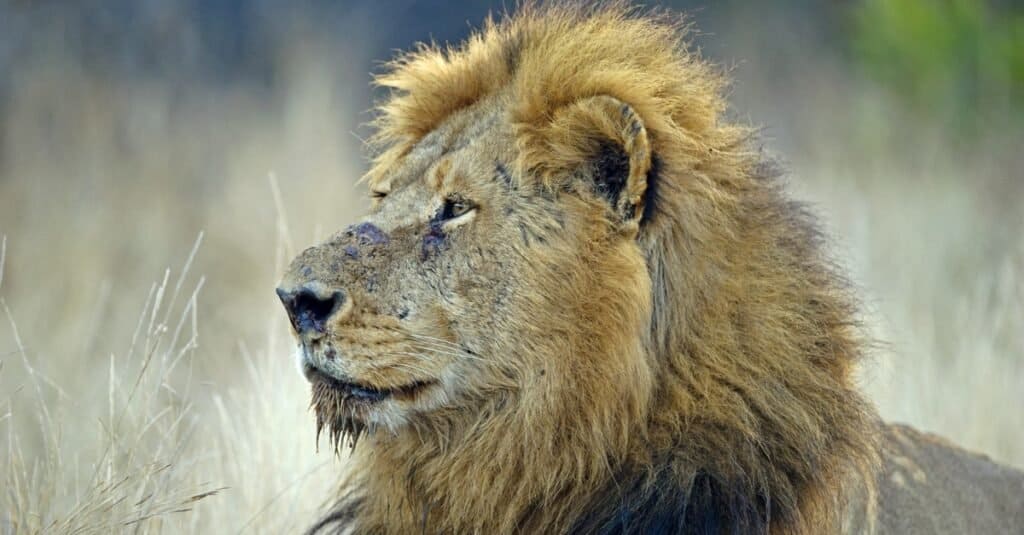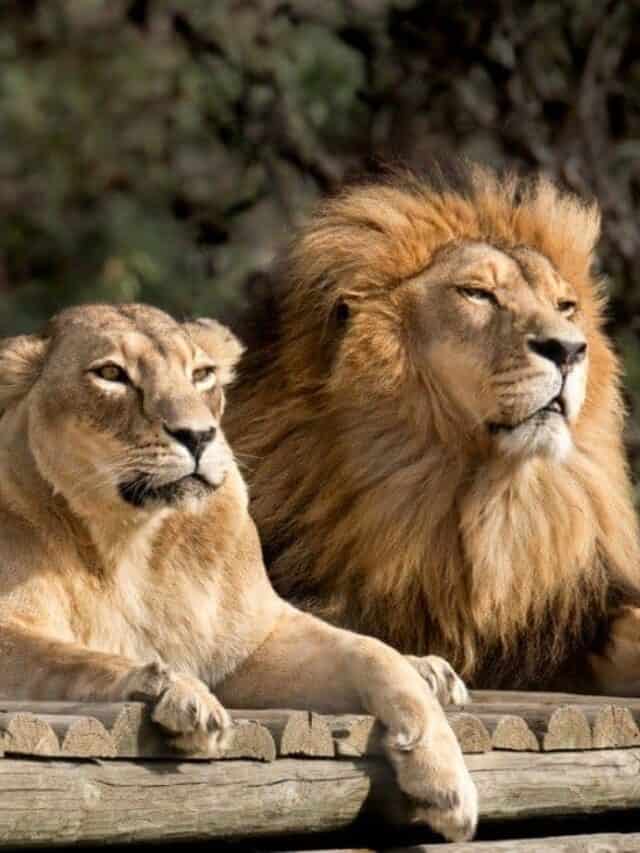Lions are majestic apex predators that roam in the wild, and issues like food availability, natural threats, and disease can all play a role in their lifespan. Even with their top predator status, there are still many threats that lead them to live a shorter life in the wild than they would experience in captivity.
Lions are genetically predisposed to be strong. Their bodies are programmed to grow strong bones and muscles so that they can attack and kill large animals.
In the Wild
Female lions have an average lifespan of about 15-16 years in the wild, while males live 8-10 years, depending on their access to nutrition and their natural habitat. However, once a lion reaches age 10, they start to become weak and are unable to provide for themselves as they have been. The lioness has a longer lifespan than a male, even with these challenges.
Old age isn’t a luxury that most of these big cats are afforded as the result of conflicts with other male lions to be the alpha male in their pride. Males must leave the pride that they are born in during adulthood, but the struggle to find the power they need to thrive leads to an early death.
Lions that reach age 10 or older may be exiled for their lack of ability to perform the tasks needed of them by the pride. Other male lions will challenge each other for authority over the pride before the defeated male is cast out.
If anything, hunger is the biggest killer of lions of this age. Females are raised to hunt with the pride, giving them the advantage of knowing how to feed themselves. They also are able to live with their birth pride when they are older because they do not have to fight for power. In fact, when male lions attack each other, they leave every lioness alone.

An old lion surveys his territory. Female lions live longer than males, as they are used to hunting in groups.
In Captivity
For lions in captivity, the average lifespan can be much greater because they don’t have natural threats. Instead, they are cared for by zookeepers who provide them with healthcare, food, and other necessities.
There are no challenges for power that can overthrow male lions, and no lioness has to hunt for their food. The only possible cause of death for most lions in captivity is their old age.
When provided with the right environment, it isn’t unheard of for a lion to surpass 20 years old. In some cases (like that of Arjun and Zenda), they may even live to be 25 or 26 years old. Lions tend to do well in captivity, thriving with constant attention from their caregivers.
Longest Lifespan
The records on the longest-living lion or lioness are a little muddled, suggesting that there has been a lion that lived for 29 years in captivity. However, the two animals below seem to be the oldest of any recorded lion or lioness, thanks to the care that they received while in captivity.

Female lions have an average lifespan of about 15-16 years in the wild, while males live 8-10 years.
Arjun: The Oldest Lion Who Ever Lived
While the majority of lions only make it to about 20 years old with ideal care, Arjun is the oldest lion to have lived in recorded history. He lived at the Animal Rescue Center in India. He never lived in the wild for a single day of his life, as he was bred in captivity.
There are many accounts of how old he actually was when he passed, suggesting he was between 26 and 29 years old when he died on May 17th, 2018. His cause of death was multiple organ failure, which was likely due to his old age.
Zenda: The Second Oldest Lion Who Ever Lived
In second place is Zenda, who lived to 25 years old in captivity before her death. She lived at the Philadelphia Zoo in the United States, featured as their African lion. This long life is much higher than that of other African lions since their average lifespan is about 10-14 years in the wild and about 20 years in captivity.
She was born in the Johannesburg Zoo in South Africa and lived there until 1993. When she was transferred to Philadelphia, she came with two other lionesses and a male lion in one pride. For a short time from 2004 to 2006, Zenda was transferred to the Columbus Zoo, quickly returning to her home at the Philadelphia Zoo instead.
Zenda passed away in captivity in the Philadelphia Zoo on December 29th, 2016. Her longtime caretaker for the 24 years prior – Kay Buffamonte – said that Zenda was the calming peacemaker of her pride. At the time, she was fairly healthy, consuming 10 pounds of steak on the Monday before her death.
She was ultimately euthanized after being in distress for more than 24 hours.
The only sign of her health issues was her sudden lack of appetite.
Ram: The Oldest Lion Who Lived in the Wild
Though it is difficult to track every known lion in the wild, a lion named Ram seemingly the oldest lion to survive in the wild, passed away at 16 years of age. He resided in the tourism zone of the Gir sanctuary where he had lived since 2009.
Though most lions do not maintain their power over territory for more than three years in the wild, Ram and his brother Shyam managed to maintain their power for almost seven years. The death of Ram made guards nervous that the cubs under the rule of these big cats would be threatened by other male lions who sought to rule the area.
Ram died in November 2015 in India.
Amazing Lion Facts
Beyond knowing the oldest lions ever recorded, there are many more amazing facts to be learned about lions. Here are a few below, but to learn more check out our article 13 Mind-Blowing Lion Facts:

Scientists have found that human activity has contributed to a large amount of lion deaths.
Unfortunately, lions that live in the wild face a greater number of threats than those that are in captivity. From the moment they are born, they must battle with issues in their environments, from disease and starvation to attacks from other lions or injury in the course of hunting. The odds of a wild lion succeeding to adulthood is increasingly more difficult and by far, the biggest threat is humans.
Scientists have found that human activity has contributed to a large amount of lion deaths. Not only because of hunting and poaching but also loss of habitat and other factors that contribute to natural difficulties. These activities contributed to 88% of male mortality and 67% of female mortality, with the male lions mainly caused by trophy hunting.




